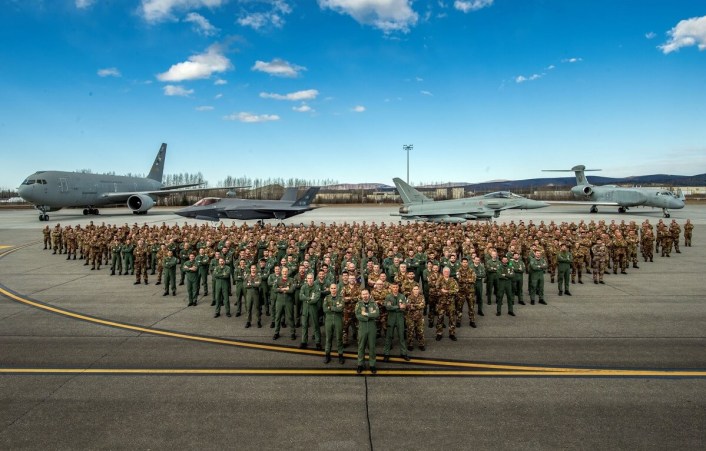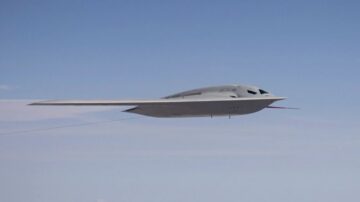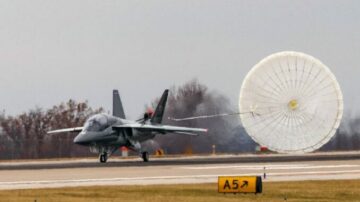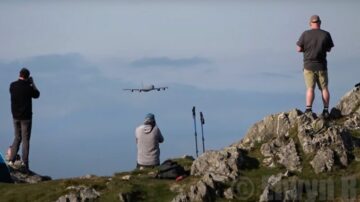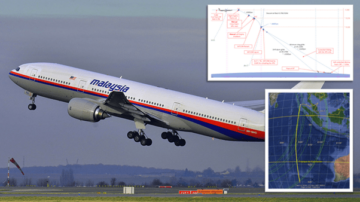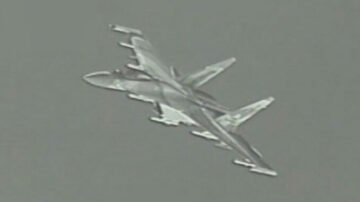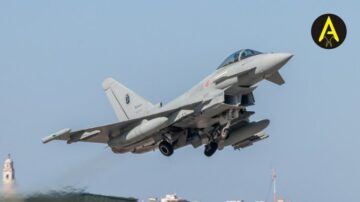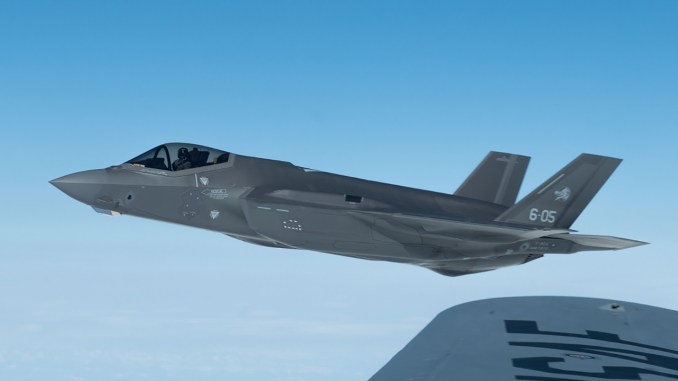
Italy deployed Typhoons, F-35s, a KC-767, and a G550 CAEW to Alaska for the first time to take part in the two-week exercise with other U.S. assets. Interestingly, the Italian F-35s flew for the first time (at least publicly) without radar reflectors.
After over two weeks of intense flight operations, the Italian Air Force successfully completed its participation to the Red Flag Alaska 24-1 exercise. The exercise, which ran from Apr. 18 to May 3, 2024, at Eielson Air Force Base, saw the Italians taking part in the large force employment training event with Typhoons, F-35s, a KC-767, and a G550 CAEW for the first time in Alaska.
Red Flag Alaska 24-1 allowed aircrews to validate weapons’ capabilities and tactics in modern highly variable and complex scenarios. The Italian assets flew two daily missions for a total of over 260 sorties and over 600 flight hours over the Joint Pacific Range Complex, integrating with assets of the U.S. Air Force, U.S. Navy, and U.S. Marine Corps.
Interestingly, the Italian F-35s flew without the radar cross-section enhancers throughout the exercise, as proved by all the photos released by both the Italian and the U.S. Air Force during RF-A 24-1. To our knowledge this is the first time images of the Italian Air Force F-35s in full “stealth mode” are released.
Radar reflectors are used to make the low observable aircraft, such as the F-35, visible to radars and are usually equipped for training and peacetime operations. Without them, the F-35s are flying with their lowest radar “signature”, taking full advantage of their low-observable capabilities as they tackle tactical scenarios with the highest realism in an almost unrestricted airspace, with both simulated and real threats.
“Having the opportunity to train together with assets and personnel from different operational communities, in a challenging training context and together with US allies, allowed us to better understand each other’s strengths and capabilities and to practice advanced tactics in A2AD scenarios (Anti Access Area Denial)”, said Col. Vito Cracas, Commander of the Eielson Autonomous Flight Unit. “One of the pillars of any modern air force is the principle “train as you fight, and fight as you train”. During a flying exercise like Red Flag Alaska we all experience a progression in the challenge so that participants can share ideas and lessons learned, in order to best utilize the capabilities of each platform, emphasizing its strengths and minimizing those of weakness, thus achieving the final objective, all the tasks of the specific mission, in a more effective way”.
An Italian F-2000 Typhoon takes off from Eielson A.F.B. for a mission. (Photo: Italian Air Force)
” data-medium-file=”https://i0.wp.com/theaviationist.com/wp-content/uploads/2024/05/Red_Flag_Alaska_24-1_1-1.jpg?fit=460%2C259&ssl=1″ data-large-file=”https://i0.wp.com/theaviationist.com/wp-content/uploads/2024/05/Red_Flag_Alaska_24-1_1-1.jpg?fit=706%2C397&ssl=1″ class=”size-large wp-image-86035″ src=”https://platoaistream.net/wp-content/uploads/2024/05/italian-air-force-f-35s-flew-in-full-stealth-mode-during-red-flag-alaska-24-1-1.jpg” alt=”Red Flag Alaska 24-1″ width=”706″ height=”397″ srcset=”https://platoaistream.net/wp-content/uploads/2024/05/italian-air-force-f-35s-flew-in-full-stealth-mode-during-red-flag-alaska-24-1-1.jpg 706w, https://platoaistream.net/wp-content/uploads/2024/05/italian-air-force-f-35s-flew-in-full-stealth-mode-during-red-flag-alaska-24-1-5.jpg 460w, https://platoaistream.net/wp-content/uploads/2024/05/italian-air-force-f-35s-flew-in-full-stealth-mode-during-red-flag-alaska-24-1-6.jpg 128w, https://platoaistream.net/wp-content/uploads/2024/05/italian-air-force-f-35s-flew-in-full-stealth-mode-during-red-flag-alaska-24-1-7.jpg 768w, https://platoaistream.net/wp-content/uploads/2024/05/italian-air-force-f-35s-flew-in-full-stealth-mode-during-red-flag-alaska-24-1-8.jpg 678w, https://i0.wp.com/theaviationist.com/wp-content/uploads/2024/05/Red_Flag_Alaska_24-1_1-1.jpg?w=1200&ssl=1 1200w” sizes=”(max-width: 706px) 100vw, 706px” data-recalc-dims=”1″>
The ItAF also mentioned that, on Apr. 26, the E550A CAEW (Conformal Airborne Early Warning) took for the first time the role of Mission Commander during a Red Flag Alaska mission. Specifically, the service said the role was assigned to the Tactical Director of the CAEW’s mission crew, which then became responsible also for the planning and the overall conduct of the entire flight mission.
In addition to the Mission Commander role, which underlines the international appreciation of the ItAF’s professionality and capabilities, Italian crews had also a chance to take part in artic survival training with the 353rd Combat Training Squadron, which specializes in Artic Survival, Evasion, Resistance, and Escape (SERE). As part of this activity, pilots simulated the ejection over hostile territory and the subsequent Combat Search & Rescue (C-SAR) effort.
Interestingly, the Italian F-35s flew without the radar cross-section enhancers throughout the exercise, as proved by all the photos released by both the Italian and the U.S. Air Force during RF 24-1. To our knowledge this is the first time images of the Italian Air Force F-35s in full “stealth mode” are released.
The Eielson Autonomous Flight Unit
The Italian Air Force established at Eielson A.F.B. the Reparto di Volo Autonomo, or the Autonomous Flight Unit, with four different assets which deployed for the first time to Alaska. The service noted that, because of logistic reasons, the G550 CAEW was based at the nearby Fairbanks International Airport.
As we already reported, the Italian detachment was composed of:
- Six F-2000As (as the single-seater Typhoons are designated in Italy in accordance to the MOD’s Mission Design Series) from the 4°, 36°, 37° and 51° Stormo (4-9, 4-66, 36-42, 36-47, 37-08, 51-56);
- Six F-35As from the 6° and 32° Stormo (6-03, 6-04, 6-05, 6-06, 6-07, 32-16);
- One KC-767A from the 14° Stormo;
- One E-550A CAEW (Conformal Airborne Early Warning) from the 14° Stormo;
- A team of Joint Terminal Attack Controllers from the 17° Stormo Incursori (Raiders).
The deployment phase, which the Aeronautica Militare used to test its airpower rapid projection capabilities, saw the aircraft departing on Apr. 4 and 6 and arriving in Alaska on Apr. 9 and 10, after a flight divided into four legs, with fuel stops at Lajes Air Base (Azores, Portugal), Pease Air National Guard Base (New Hampshire), Joint Base Lewis-McChord (Washington) and then Eielson Air Force Base.
With this detachment of four different aircraft types, the Italian Air Force was able to cover a very large set of airpower capabilities. Specifically, the Typhoons worked on their swing role capability, while the F-35 brought their omnirole capabilities. The KC-767 tanker provided air refueling capability, flying also joint missions with the U.S. KC-46s, while the E-550 CAEW flew in its main roles of Airborne Early Warning and Battle Management and Command and Control (BM&C2).
Red Flag Alaska 24-1
Red Flag-Alaska utilizes the vast Joint Pacific-Alaska Range Complex to provide each aircrew member with their first 10 combat sorties and enable U.S. and international partners to work together for any future contingency. The exercise allows to take full advantage of the large airspace with few restrictions, which includes military operating areas and bombing ranges for a total surface of over 67,000 square miles (more than half of the surface of Italy), which allows participants to operate their weapon systems almost without limits.
“RED FLAG-Alaska is designed to provide combat aviators with the experience of seeing all the fog and friction of combat before they actually have to go do it,” said U.S Air Force Lt. Col. Lloyd Wright, 354th Operations Group Detachment 1 commander. “We try to simulate, in a combat-representative way, scenarios that they are going to see in the real world as closely as we can. We incorporate surface-to-air and air-to-air threats, as well as complex scenarios requiring integration, planning and deeper thought than what they would get at home in day-to-day training.”
Large Force Employment exercises such as Red Flag allow aircrews to expand their training with scope and scale way larger than they would get at their home bases because of airspace constraints, lack of adequate ranges, civilian air traffic. Also, aircrews get a chance to gain perspective outside of their normal training evolutions at their home station, a key takeaway in becoming better aviators.
“Perspective is the big thing from my view,” said Wright. “The ability to integrate, learn what other platforms, what other nations, and what other communities do and are capable of and how to better integrate with them to make a cohesive mission go forward. The scope and scale is something they can’t get at home. At home, they would be fighting a 4vs4 [four versus four aerial fight], while here they face 28vs20 [28 versus 20 aerial fight].”
Italy was the only foreign nation taking part to RF-A 24-1 with aircraft, while the Netherlands sent a team of Joint Terminal Attack Controllers. The other units involved belong to the U.S. Air Force, Marine Corps and Navy:
- 36th Fighter Squadron, Osan Air Base, Republic of Korea, F-16CM Block 40;
- 80th Fighter Squadron, Kunsan Air Base, Republic of Korea, F-16CM Block 40;
- Marine Attack Squadron (VMA) 223, Marine Corps Air Station Cherry Point, North Carolina, AV-8B;
- Marine Aerial Refueler Transport Squadron (VMGR) 234, Naval Air Station Joint Reserve Base Fort Worth, Texas, KC-130J;
- Electromagnetic Attack Squadron (VAQ) 131, Naval Air Station Whidbey Island, Washington, EA-18G.
Each of these units brings a precise mission set: multirole/swing-role missions, ground attack, Suppression of Enemy Air Defenses, aerial refueling, Airborne Early Warning – Battlefield Management, and Communication. In fact, each exercise is a joint/coalition, tactical air combat employment exercise that corresponds to the operational capability of participating units, whose mission may differ significantly from those of other participating units but complements them to bring all the required abilities needed to tackle modern scenarios.

- SEO Powered Content & PR Distribution. Get Amplified Today.
- PlatoData.Network Vertical Generative Ai. Empower Yourself. Access Here.
- PlatoAiStream. Web3 Intelligence. Knowledge Amplified. Access Here.
- PlatoESG. Carbon, CleanTech, Energy, Environment, Solar, Waste Management. Access Here.
- PlatoHealth. Biotech and Clinical Trials Intelligence. Access Here.
- Source: https://theaviationist.com/2024/05/10/itaf-f-35-rf-24-1/?utm_source=rss&utm_medium=rss&utm_campaign=itaf-f-35-rf-24-1
- :is
- 000
- 1
- 10
- 125
- 20
- 2024
- 234
- 26
- 28
- 4
- 40
- 5
- 6
- 67
- 800
- 9
- a
- abilities
- ability
- Able
- access
- accordance
- Achieve
- achieving
- activity
- actually
- addition
- adequate
- advanced
- ADvantage
- Aerospace
- aerospace engineering
- After
- AIR
- Air Force
- air-to-air
- aircraft
- airport
- airspace
- alaska
- All
- allow
- allowed
- allows
- almost
- already
- also
- among
- an
- and
- any
- applied
- appreciation
- apr
- ARE
- AREA
- areas
- arriving
- AS
- Assets
- assigned
- At
- attack
- autonomous
- avatar
- b
- base
- based
- Battle
- Battlefield
- BE
- became
- because
- becoming
- before
- BEST
- Better
- Big
- Block
- both
- bring
- Brings
- brought
- but
- by
- CAN
- capabilities
- capability
- capable
- Carolina
- challenge
- challenging
- Chance
- civilian
- closely
- cohesive
- combat
- command
- Communication
- Communities
- complements
- Completed
- complex
- composed
- Conduct
- conflicts
- constraints
- context
- contributor
- control
- corps
- corresponds
- cover
- crew
- Current
- daily
- day-to-day
- deeper
- defenses
- Degree
- deployed
- deployment
- Design
- designated
- designed
- differ
- different
- Director
- divided
- do
- during
- each
- Early
- Effective
- effort
- ejection
- Electronic
- emphasizing
- employment
- enable
- Engineering
- Entire
- equipped
- escape
- established
- Ether (ETH)
- evasion
- Event
- evolutions
- Exercise
- Expand
- experience
- expertise
- Face
- fact
- few
- fight
- fighters
- fighting
- final
- First
- first time
- flight
- flying
- Fog
- For
- Force
- foreign
- Fort
- Forward
- four
- freelance
- friction
- from
- Fuel
- full
- future
- Gain
- get
- Go
- going
- graduate
- Ground
- Group
- Guard
- had
- Half
- Hampshire
- Have
- he
- here
- highest
- highly
- his
- Home
- hostile
- How
- How To
- HTTPS
- ideas
- ii
- images
- in
- includes
- incorporate
- integrate
- Integrating
- integration
- intense
- International
- into
- involved
- island
- IT
- Italian
- Italy
- ITS
- Japan
- joint
- journalist
- jpeg
- jpg
- Kadena
- Key
- knowledge
- korea
- Lack
- large
- larger
- LEARN
- learned
- least
- legs
- Lessons
- Lessons Learned
- lightning
- like
- limits
- Low
- lowest
- Main
- make
- management
- Marine
- master
- max-width
- May..
- member
- mentioned
- Military
- minimizing
- Mission
- missions
- Mode
- Modern
- more
- my
- nation
- National
- Nations
- needed
- Netherlands
- New
- next
- normal
- North
- north carolina
- noted
- objective
- of
- off
- on
- only
- operate
- operating
- operational
- Operations
- Opportunity
- or
- order
- osint
- Other
- our
- outside
- over
- overall
- Pacific
- part
- participants
- participating
- participation
- partners
- Personnel
- perspective
- phase
- photo
- Photos
- pillars
- Pilots
- planning
- platform
- Platforms
- plato
- Plato Data Intelligence
- PlatoData
- Point
- Portugal
- practice
- precise
- principle
- progression
- Projection
- proved
- provide
- provided
- publicly
- radar
- ran
- range
- ranges
- rapid
- RE
- real
- real world
- realism
- reasons
- Red
- Refueling
- released
- Reported
- Republic
- required
- Reserve
- Resistance
- responsible
- restrictions
- Role
- roles
- s
- Said
- saw
- Scale
- scenarios
- scope
- Search
- see
- seeing
- sent
- Series
- service
- set
- Share
- significantly
- simulate
- single-seater
- So
- something
- specializes
- specific
- specifically
- square
- station
- Stealth
- Stops
- strengths
- Studying
- subsequent
- Successfully
- such
- Supports
- suppression
- Surface
- survival
- Swing
- Systems
- tackle
- tactical
- tactics
- Take
- takes
- taking
- tasks
- team
- techniques
- Terminal
- territory
- test
- texas
- than
- that
- The
- the joint
- the Netherlands
- the world
- their
- Them
- then
- These
- they
- thing
- this
- those
- thought
- threats
- three
- throughout
- Thus
- time
- to
- together
- took
- Total
- traffic
- Train
- Training
- transport
- try
- two
- types
- u.s.
- U.S. Air Force
- U.S. Navy
- underlines
- understand
- unit
- units
- unrestricted
- us
- used
- usually
- utilize
- utilizes
- VALIDATE
- variable
- Vast
- Versus
- very
- View
- visible
- vma
- warning
- was
- washington
- Way..
- we
- weakness
- Weeks
- WELL
- What
- which
- while
- whose
- with
- without
- Work
- work together
- worked
- world
- worth
- would
- Wright
- you
- zephyrnet


